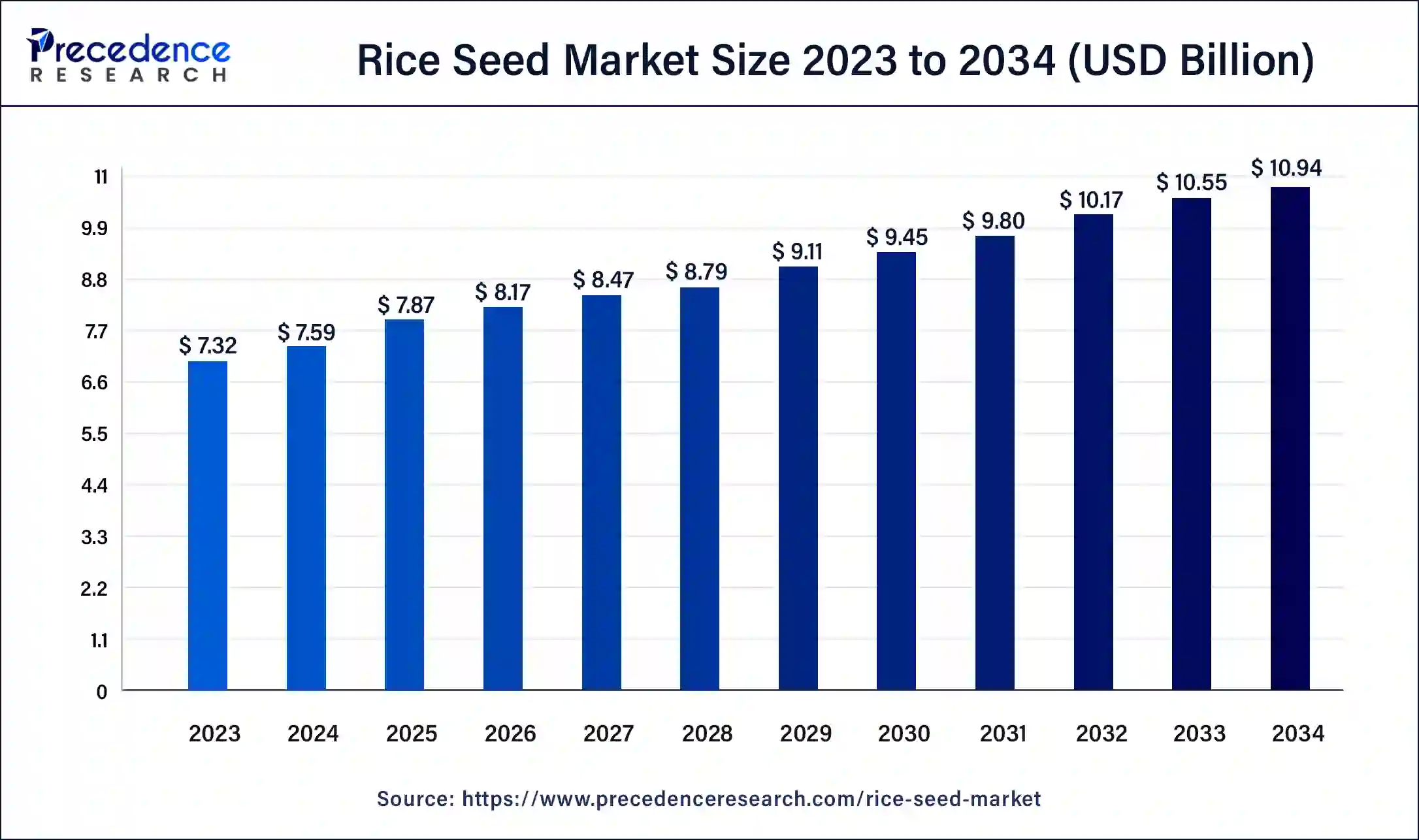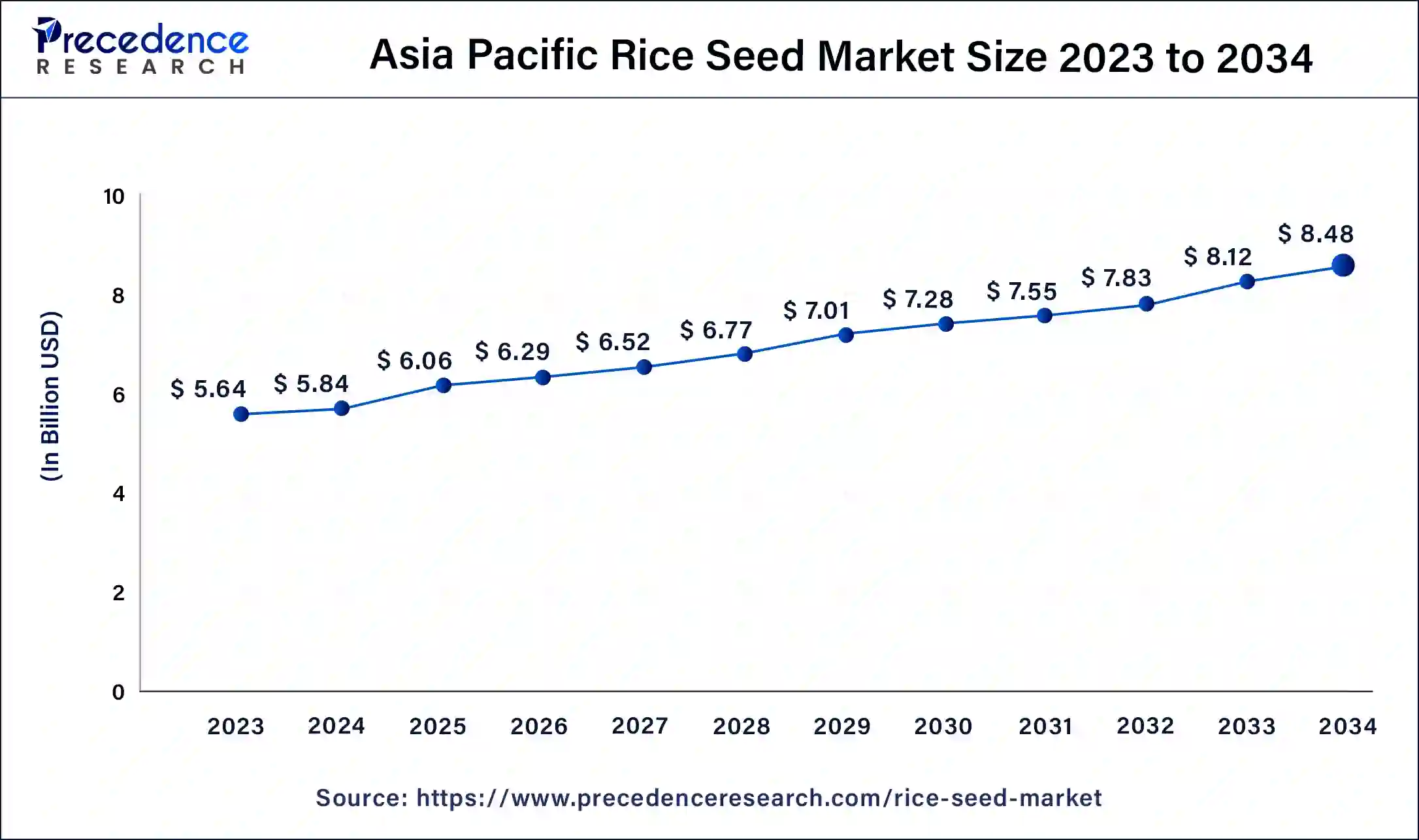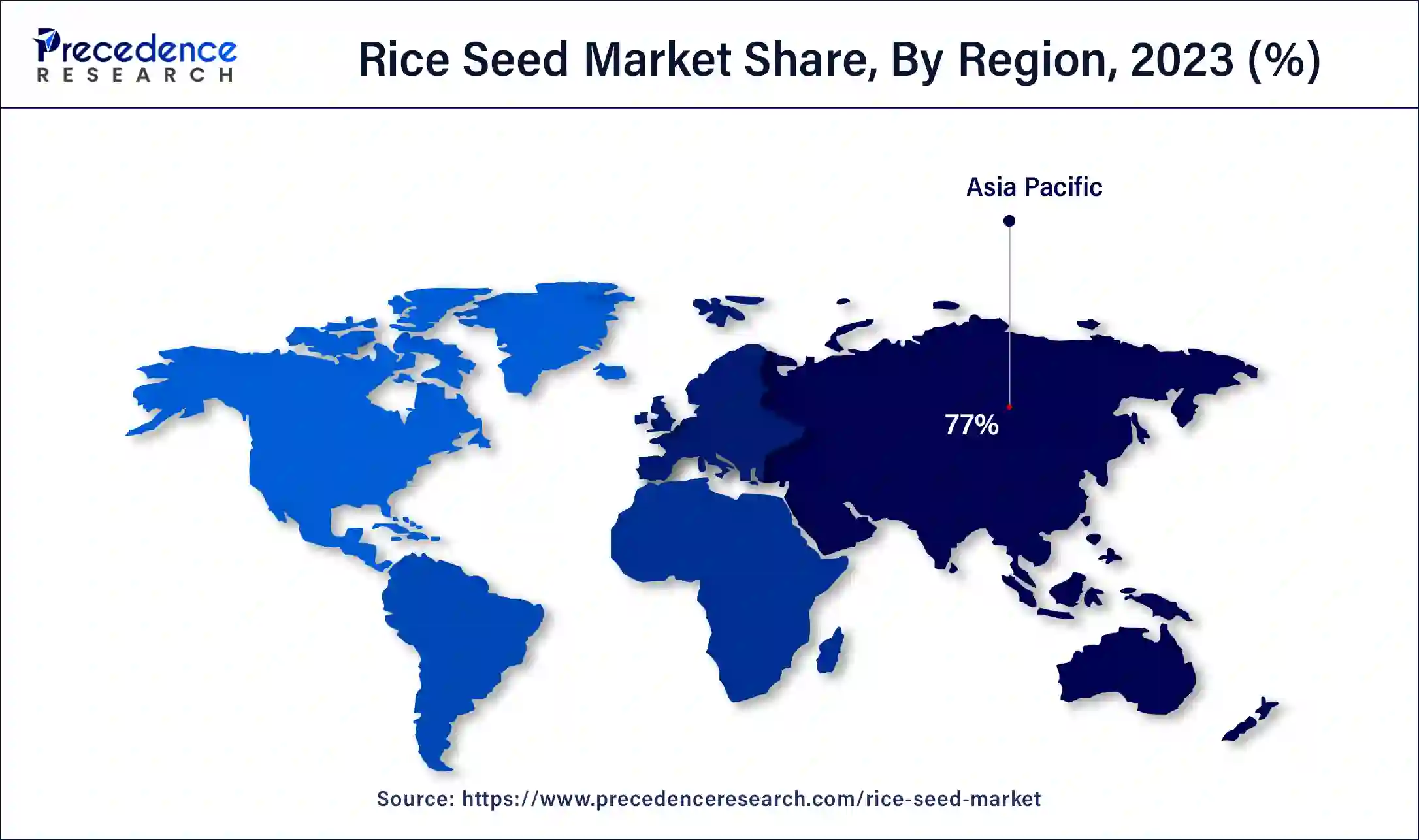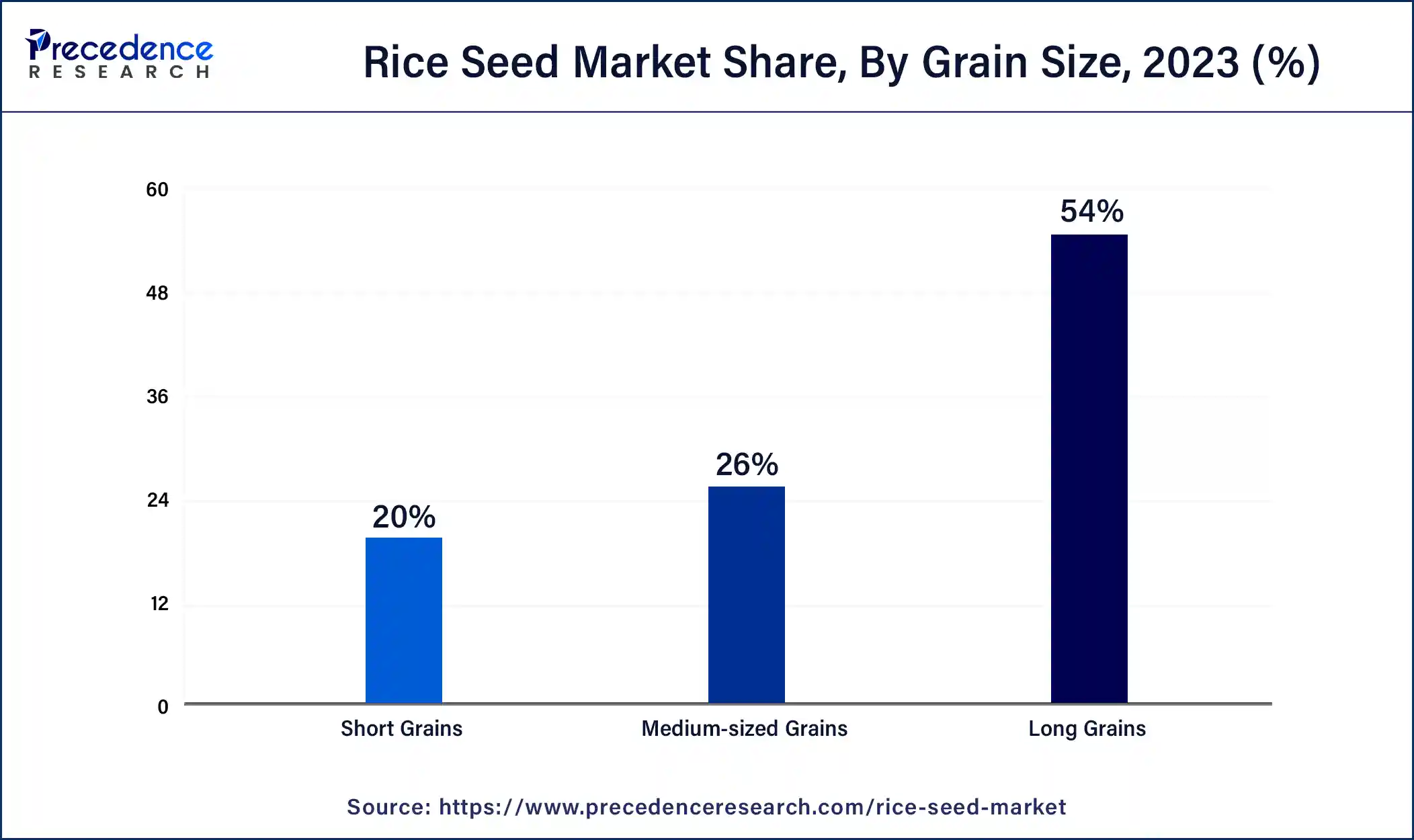July 2024
The global rice seed market size was USD 7.32 billion in 2023, calculated at USD 7.59 billion in 2024 and is expected to be worth around USD 10.94 billion by 2034. The market is slated to expand at 3.72% CAGR from 2024 to 2034.
The global rice seed market size is worth around USD 7.59 billion in 2024 and is anticipated to reach around USD 10.94 billion by 2034, growing at a CAGR of 3.72% over the forecast period 2024 to 2034. The growing adoption of hybrid rice seeds is expected to drive the growth of the rice seed market.

The Asia Pacific rice seed market size was exhibited at USD 5.64 billion in 2023 and is projected to be worth around USD 8.48 billion by 2034, poised to grow at a CAGR of 3.77% from 2024 to 2034.

Asia Pacific dominated the global rice seed market in 2023. The region is a major producer and consumer of rice in the world. The insufficient agricultural land has inspired farmers to better yield from their cultivation in the region. The rising adoption of advanced technologies such as certified and hybrid seeds is also growing. With the various market players who have technological capacities, strong research and development activities, and global presence to address the increasing demand across the globe, the market for the competitive landscape of rice seeds is highly fragmented. Collaboration and new product launches are some of the policies that are being integrated by market players.
In addition, China and India are the fastest growing countries in rice and these countries have top companies in the rice seed market. In China, there are various top companies in rice seed, such as Zhongnongfa Seed Industry Group Co. Ltd, Yuan Longping High-Tech Agriculture Co. Ltd, Hefei Fengle Seed Industry Co. Ltd, Beidahuang Kenfeng Seed Co. Ltd, Anhui Tsuen Yin Hi-Tech Seed Industry Co. Ltd, and many others.

North America is expected to witness significant growth in the rice seed market over the forecast period. North America is also showing significant growth in rice seeds due to consumers' good eating habits. The U.S. and Canada are the major countries in the region. After sorghum, wheat, and corn, rice production is the fourth largest among cereals in the U.S. rice farms have the highest national land and are the most capital-intensive due to the row crop farms in the U.S. rice production is connected to the agriculture using first planting African rice and labor in the American South.
The rice seed market deals with a diverse range of professional parties, such as agricultural researchers, seed producers, breeders, government agencies, and farmers. Breeders must conduct detailed research and development to create new rice varieties and focus on characteristics that boost productivity and resistance. These modified rice seeds are made available and produced via a variety of channels, such as seed corporations, cooperatives, and government initiatives.
The increasing consumption of rice as a major food crop over the globe is expected to drive the growth of the rice seed market. Rice seeds are commonly available in jasmine, white, brown, basmati, and arborio rice seed variants. In addition, there is an increasing demand for OPV seeds, with the increasing adoption of organic rice-based farming practices to address the growing consumers' food requirements.
How can Artificial Intelligence (AI) improve the Rice Seed Market?
Artificial intelligence techniques have great potential to offer data related to the quality of soil, when to sow in agriculture, and where to spray herbicide; this is the maximum probability of pest infestation. AI technology has been used globally, which aids farmers in optimizing the efficiency for monitoring crop health in the rice seed market. They can be used to manage diseases in rice seeds. AI techniques that have been used for creating and developing intelligent machines are used for rice seed management with higher accuracy than humans can.
| Report Coverage | Details |
| Market Size by 2034 | USD 10.94 Billion |
| Market Size in 2024 | USD 7.59 Billion |
| Market Growth Rate from 2024 to 2034 | CAGR of 3.72% |
| Largest Market | Asia Pacific |
| Base Year | 2023 |
| Forecast Period | 2024 to 2034 |
| Segments Covered | Grain Size, Treatment, Hybridization Technique, and Regions |
| Regions Covered | North America, Europe, Asia-Pacific, Latin America and Middle East & Africa |
Rising demand for hybrid rice seeds
Hybrid seeds are becoming more and more popular due to their increased resilience and production to pests and illnesses. Hybrid rice seeds held a significant share of the rice seed market in recent years, and this market share is expected to rise in the coming years. The necessity to increase rice output to address the demands of an increasing population is accelerating the increasing demand for hybrid rice seeds.
High R&D costs and regulatory hurdles
The higher adoption of hybrid rice is hampered by factors such as high research and development costs and longer regulatory approvals. Due to the frequent changes in law amendments and enforcement, regulatory approvals are time-consuming and are regulated by the regulations and rules laid down by the government. For instance, in developing countries, seed bills were passed, which spoiled seed freedom and sovereignty with weaker rights of the farmers. These factors cause clashes between the government and farmers, hindering the overall seed industry. Another restraining factor is high R&D costs. Thus, the overall hybrid rice seed manufacturing and development is a costly and long process that acts as a major challenge and is further expected to restrain the growth of the rice seed market.
Digital agriculture, precision farming, and evolving distribution routes
The increasing adoption of data analytics and digital technologies in agriculture is expanding the rice seed market. Precision farming techniques enable farmers to make valid decisions regarding seed application and selection based on site-specific variables, and that's why they improve yields and resource utilization.
The evolving distribution routes in the rice seed market are creating new opportunities. Traditional seed distribution methods are changing because more farmers are using mobile applications and internet platforms. These platforms allow farmers to communicate directly with seed producers and make it easier for them to access high-quality seeds. This trend is expected to become more popular, especially in developing countries.
The long-grain rice seeds segment is expected to grow at the fastest rate in the rice seed market during the forecast period. This is leading to a high rate of cultivation in various countries such as Asia Pacific and North America. Long-grain rice is thinner and longer than short-grain rice. This results in a more fluffy, dry, and separate texture when cooked. After cooking, the longer grains also tend to hold their shape better. This long-grain rice has a neutral and mild flavor. This makes it more versatile for pairing with a various range of sauces and dishes. It also had a more delicate aroma. Long-grain rice varieties tend to have a lower carbohydrate and calorie content per serving due to their longer grain shape. Due to the slightly longer cooking time, long rice grain is beneficial for certain meal preparation and cooking methods.

The untreated rice seeds segment accounted for the highest share of the rice seed market in 2023. Treatment of seeds and their adoption has been receiving attraction for field crops, such as soybean, wheat, and corn, to minimize crop loss from pest attacks. Rice is particularly cultivated in countries such as Asia Pacific. Farmers are preferred adopting the traditional techniques of crop protection and are reluctant to invest capital in crop inputs. The increasing need for integrated pest management and sustainable agriculture management guidelines conducted by governments has inspired farmers to adopt seed coating technologies in Asian countries.
The three-line system segment is attributed to having the highest share of the rice seed market in 2023. The three-line systems are adopted by major players in the Asia countries for hybrid seed production. Various companies have been depending on the three-line system for product development. A major advance in rice breeding is hybrid rice development. It has demonstrated its immense potential in improving rice productivity. The restoration of fertility of the widely used wild-abortive type of cytoplasmic male sterility is controlled by Rf3 and Rf4 in the three-line system of hybrid rice.
Segment Covered in the Report
By Grain Size
By Treatment
By Hybridization Technique
By Geography
For inquiries regarding discounts, bulk purchases, or customization requests, please contact us at sales@precedenceresearch.com
No cookie-cutter, only authentic analysis – take the 1st step to become a Precedence Research client
July 2024
July 2024
July 2024